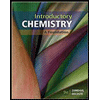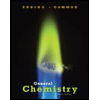![OWLv2 for Masterton/Hurley's Chemistry: Principles and Reactions, 8th Edition, [Instant Access], 1 term (6 months)](https://s3.amazonaws.com/compass-isbn-assets/textbook_empty_images/large_textbook_empty.svg)
OWLv2 for Masterton/Hurley's Chemistry: Principles and Reactions, 8th Edition, [Instant Access], 1 term (6 months)
8th Edition
ISBN: 9781305079311
Author: William L. Masterton; Cecile N. Hurley
Publisher: Cengage Learning US
expand_more
expand_more
format_list_bulleted
Textbook Question
Chapter 6, Problem 19QAP
For the following pairs of orbitals, indicate which is lower in energy in a many-electron atom.
(a) 3d or 4s
(b) 4f or 3d
(c) 2s or 2P
d) 4f or 4d
Expert Solution & Answer
Trending nowThis is a popular solution!

Students have asked these similar questions
Predict the hydrocarbon, of formula C6H10, needed to prepare the following geminal dibromide upon treatment with excess hydrobromic acid.
Note: The shown product is the only regioisomer formed in this reaction.
HBr
H₂C.
CH3
draw the major product formed with the listed reagents
Propose Williamson ether syntheses for the following compounds
Chapter 6 Solutions
OWLv2 for Masterton/Hurley's Chemistry: Principles and Reactions, 8th Edition, [Instant Access], 1 term (6 months)
Ch. 6 - A photon of violet light has a wavelength of 423...Ch. 6 - Most retinal tears and detachments are treated by...Ch. 6 - A line in the spectrum of neon has a wavelength of...Ch. 6 - Ozone absorbs energy with a frequency of 1.291015...Ch. 6 - The ionization energy of rubidium is 403 kJ/mol....Ch. 6 - Energy from radiation can cause chemical bonds to...Ch. 6 - Lasers are now used for the total or partial...Ch. 6 - Your instructor may use a laser pointer while...Ch. 6 - Consider the transition from the energy levels n=5...Ch. 6 - Consider the transition from the energy levels n=2...
Ch. 6 - According to the Bohr model, the radius of a...Ch. 6 - Calculate En for n=1,2,3, and 4 (R H=2.1801018J)....Ch. 6 - For the Pfund series, nlo=5. (a) Calculate the...Ch. 6 - In the Brackett series, nlo=4. (a) Calculate the...Ch. 6 - A line in the Lyman series (nlo=1) occurs at 97.23...Ch. 6 - In the Pfund series, nlo=5. Calculate the longest...Ch. 6 - What are the possible values for m l for (a) the d...Ch. 6 - What are the possible values for m l for (a) the d...Ch. 6 - For the following pairs of orbitals, indicate...Ch. 6 - For the following pairs of orbitals, indicate...Ch. 6 - What type of electron orbital (i.e., s, p, d, or...Ch. 6 - What type of electron orbital (i.e., s, p, d, or...Ch. 6 - What is the total electron capacity for (a)...Ch. 6 - Give the number of orbitals in (a) n=3(b) a 4p...Ch. 6 - How many electrons in an atom can following...Ch. 6 - How many electrons in an atom can have the...Ch. 6 - Given the following sets of quantum numbers,...Ch. 6 - Given the following sets of electron quantum...Ch. 6 - Write the ground state electron configuration for...Ch. 6 - Write the ground state electron configuration for...Ch. 6 - Write an abbreviated ground state electron...Ch. 6 - Prob. 32QAPCh. 6 - Give the symbol of the element of lowest atomic...Ch. 6 - Give the symbol of the element of lowest atomic...Ch. 6 - What fraction of the total number of electrons is...Ch. 6 - What fraction of the total number of electrons is...Ch. 6 - Which of the following electron configurations...Ch. 6 - Which of the following electron configurations...Ch. 6 - Write the orbital diagram for (a) Li(b) P(c) F(d)...Ch. 6 - Write the orbital diagram tor an atom of (a) Na...Ch. 6 - Give the symbol of the atom with the following...Ch. 6 - What is the symbol of the atom with the following...Ch. 6 - Write the symbol of (a) all the elements in which...Ch. 6 - Write the symbols of (a) all the elements in...Ch. 6 - How many unpaired electrons are there in an atom...Ch. 6 - How many unpaired electrons are there in the...Ch. 6 - In what main group(s) of the periodic table do...Ch. 6 - Give the symbol of the main-group metals in period...Ch. 6 - Write the ground state electron configuration for...Ch. 6 - Write the ground state electron configuration for...Ch. 6 - How many unpaired electrons are there 111 the...Ch. 6 - How many unpaired electrons are there in the...Ch. 6 - Arrange the elements Na, Si, and S in the order of...Ch. 6 - Arrange the elements Mg, S, and Cl in order of (a)...Ch. 6 - Which of the four atoms Rb, Sr, Sb, or Cs (a) has...Ch. 6 - Which of the four atoms Na, P, Cl, or K (a) has...Ch. 6 - Select the larger member of each pair. (a) Ca and...Ch. 6 - Select the smaller member of each pair. (a) P and...Ch. 6 - Prob. 59QAPCh. 6 - Prob. 60QAPCh. 6 - A lightbulb radiates 8.5% of the energy supplied...Ch. 6 - The speed of a computer chip is measured by its...Ch. 6 - A carbon dioxide laser produces radiation of...Ch. 6 - Name and give the symbol of the element that has...Ch. 6 - Compare the energies and frequencies of two...Ch. 6 - Consider the following transitions 1. n=3 to n=1...Ch. 6 - Write the symbol of each element described below....Ch. 6 - Answer the following questions. (a) What...Ch. 6 - Explain in your own words what is meant by (a) the...Ch. 6 - Explain the difference between (a) the Bohr model...Ch. 6 - Indicate whether each of the following statements...Ch. 6 - Criticize or comment on the following statements:...Ch. 6 - No currently known elements contain electrons in g...Ch. 6 - Prob. 74QAPCh. 6 - Explain why (a) negative ions are larger than...Ch. 6 - The energy of any one-electron species in its nth...Ch. 6 - In 1885, Johann Balmer, a mathematician, derived...Ch. 6 - Prob. 78QAPCh. 6 - Suppose that the spin quantum number could have...Ch. 6 - In the photoelectric effect, electrons are ejected...
Knowledge Booster
Learn more about
Need a deep-dive on the concept behind this application? Look no further. Learn more about this topic, chemistry and related others by exploring similar questions and additional content below.Similar questions
- Identify all functional groupsarrow_forwardA mixture of CaCO3 and MgC2O4 of unknown mass was heated in a 0.5 L closed rigid vessel to 900 degrees C.at 400C the following reaction occurs:MgC2O4 -> MgO (s) + CO (g) + CO2 (g)At 700C a second reaction occurs: CaCO3 -> CaO (s) + CO2 (g)The solid mass in the vessel was measured to be 3.06 g at 400C and 2.03g at 900CQuestion: What is the partial pressure of CO in both temperatures? (400 and 900C), provide detailed explanation.arrow_forwardFor the following alkyne, complete the reaction sequentially (that is draw the intermediate that we can’t stop at) and then name (complete name) all 3 molecules.arrow_forward
- Given the reaction sequence below, answer the following. A. Provide the structure for A. B. Provide the structure for B (pay attention to stereochemistry). C. Provide the structure for C. D. What are the stereochemical designations for I and II (R/S)?arrow_forwardWhich of the following is the most stable carbon radical?arrow_forwardPut the following carbon radicals in order of increasing stability.arrow_forward
- Draw the major organic product for each of the following reactions (pay attention to stereochemistry).arrow_forwardThere are 2 reactions (that you know of) to achieve the following transformation: One reaction is favored over the other because it avoids a competing reaction. A. Draw the favored reaction scheme (not the mechanism), be sure to include all necessary reagents. B. Draw the reaction scheme that is not favored and include all the possible products.arrow_forwardBoth carbocations and carbon-radicals have trigonal planar geometry. True or Falsearrow_forward
- Teflon (polytetrafluoroethene) is prepared via the radial polymerization of tetrafluoroethene. What other reaction conditions (reagent, etc.) are needed to accomplish this? A. NBS, Light B. Heat, Cl2 C. Peroxide, Heat D. H2SO4, H2O, Heatarrow_forwardWhich of the following compounds can be reacted with ethene to prepare 1,1- dichlorocyclopropane? A. CCl4 B. CCl2 C. CHCl3 D. CH2Cl2arrow_forwardusing any reactions, starting with propene, propose a synthesis for the following moleculearrow_forward
arrow_back_ios
SEE MORE QUESTIONS
arrow_forward_ios
Recommended textbooks for you
 Chemistry: Principles and ReactionsChemistryISBN:9781305079373Author:William L. Masterton, Cecile N. HurleyPublisher:Cengage Learning
Chemistry: Principles and ReactionsChemistryISBN:9781305079373Author:William L. Masterton, Cecile N. HurleyPublisher:Cengage Learning Introductory Chemistry: A FoundationChemistryISBN:9781337399425Author:Steven S. Zumdahl, Donald J. DeCostePublisher:Cengage LearningChemistry: Matter and ChangeChemistryISBN:9780078746376Author:Dinah Zike, Laurel Dingrando, Nicholas Hainen, Cheryl WistromPublisher:Glencoe/McGraw-Hill School Pub Co
Introductory Chemistry: A FoundationChemistryISBN:9781337399425Author:Steven S. Zumdahl, Donald J. DeCostePublisher:Cengage LearningChemistry: Matter and ChangeChemistryISBN:9780078746376Author:Dinah Zike, Laurel Dingrando, Nicholas Hainen, Cheryl WistromPublisher:Glencoe/McGraw-Hill School Pub Co World of Chemistry, 3rd editionChemistryISBN:9781133109655Author:Steven S. Zumdahl, Susan L. Zumdahl, Donald J. DeCostePublisher:Brooks / Cole / Cengage Learning
World of Chemistry, 3rd editionChemistryISBN:9781133109655Author:Steven S. Zumdahl, Susan L. Zumdahl, Donald J. DeCostePublisher:Brooks / Cole / Cengage Learning Chemistry for Engineering StudentsChemistryISBN:9781285199023Author:Lawrence S. Brown, Tom HolmePublisher:Cengage Learning
Chemistry for Engineering StudentsChemistryISBN:9781285199023Author:Lawrence S. Brown, Tom HolmePublisher:Cengage Learning General Chemistry - Standalone book (MindTap Cour...ChemistryISBN:9781305580343Author:Steven D. Gammon, Ebbing, Darrell Ebbing, Steven D., Darrell; Gammon, Darrell Ebbing; Steven D. Gammon, Darrell D.; Gammon, Ebbing; Steven D. Gammon; DarrellPublisher:Cengage Learning
General Chemistry - Standalone book (MindTap Cour...ChemistryISBN:9781305580343Author:Steven D. Gammon, Ebbing, Darrell Ebbing, Steven D., Darrell; Gammon, Darrell Ebbing; Steven D. Gammon, Darrell D.; Gammon, Ebbing; Steven D. Gammon; DarrellPublisher:Cengage Learning

Chemistry: Principles and Reactions
Chemistry
ISBN:9781305079373
Author:William L. Masterton, Cecile N. Hurley
Publisher:Cengage Learning

Introductory Chemistry: A Foundation
Chemistry
ISBN:9781337399425
Author:Steven S. Zumdahl, Donald J. DeCoste
Publisher:Cengage Learning

Chemistry: Matter and Change
Chemistry
ISBN:9780078746376
Author:Dinah Zike, Laurel Dingrando, Nicholas Hainen, Cheryl Wistrom
Publisher:Glencoe/McGraw-Hill School Pub Co

World of Chemistry, 3rd edition
Chemistry
ISBN:9781133109655
Author:Steven S. Zumdahl, Susan L. Zumdahl, Donald J. DeCoste
Publisher:Brooks / Cole / Cengage Learning

Chemistry for Engineering Students
Chemistry
ISBN:9781285199023
Author:Lawrence S. Brown, Tom Holme
Publisher:Cengage Learning

General Chemistry - Standalone book (MindTap Cour...
Chemistry
ISBN:9781305580343
Author:Steven D. Gammon, Ebbing, Darrell Ebbing, Steven D., Darrell; Gammon, Darrell Ebbing; Steven D. Gammon, Darrell D.; Gammon, Ebbing; Steven D. Gammon; Darrell
Publisher:Cengage Learning
Quantum Numbers, Atomic Orbitals, and Electron Configurations; Author: Professor Dave Explains;https://www.youtube.com/watch?v=Aoi4j8es4gQ;License: Standard YouTube License, CC-BY
QUANTUM MECHANICAL MODEL/Atomic Structure-21E; Author: H to O Chemistry;https://www.youtube.com/watch?v=mYHNUy5hPQE;License: Standard YouTube License, CC-BY